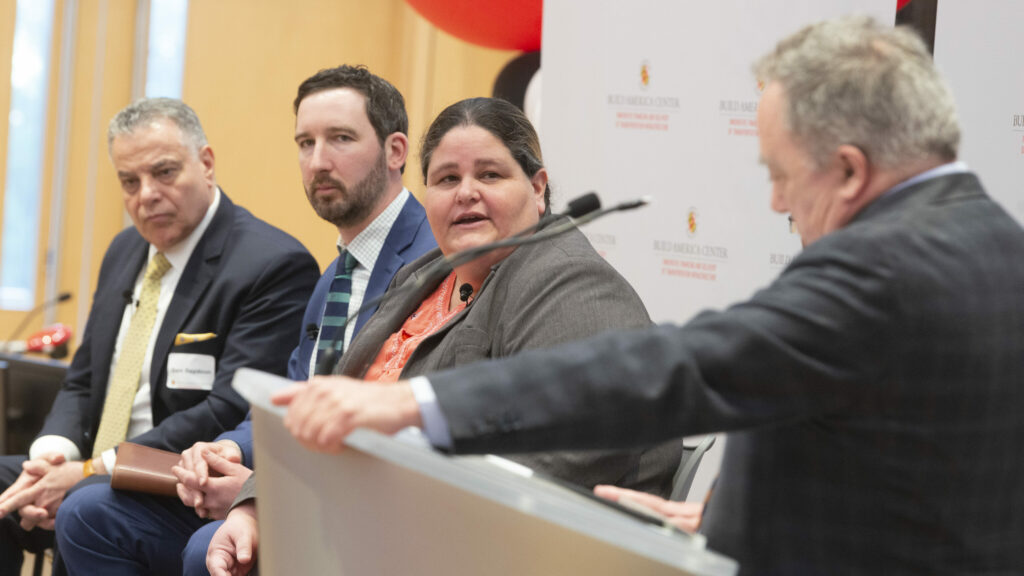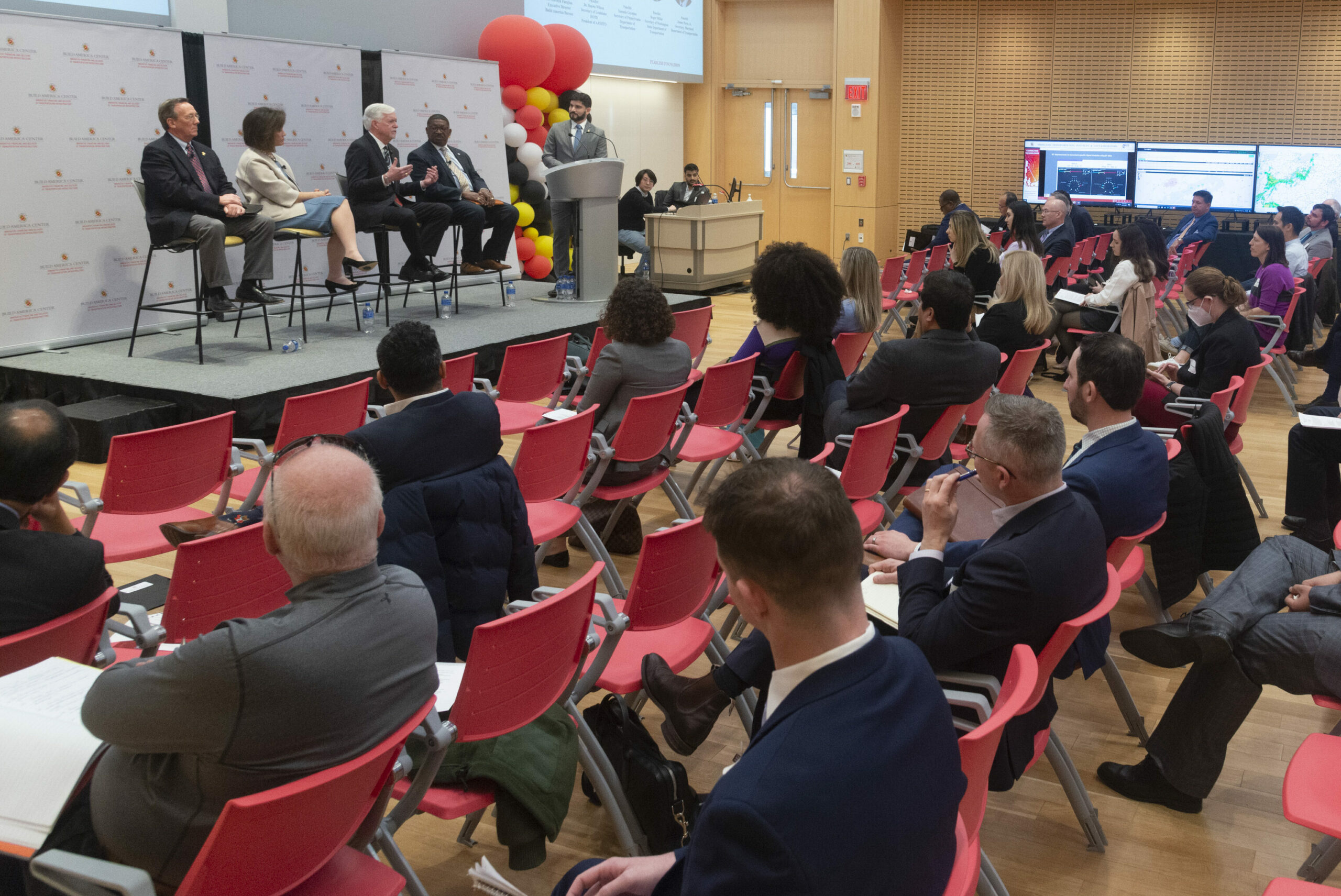Key leaders from the U.S Department of Transpiration, State Departments of Transportation and the University of Maryland participated in the Build America Center’s first official event, the Build Infrastructure Better Symposium, on April 11, 2022 at the University of Maryland College Park Campus.
The two expert panels focused on state implementation of the infrastructure law and on financing and delivery methods.
View Recording of Panel Session One
View Recording of Panel Session Two
Expert Panel #1 – Build Better Infrastructure under the Bipartisan Infrastructure Law (BIL)
Moderator: Morteza Farajian, Executive Director, Build America Bureau
Panelists:
- Shawn Wilson, Secretary of Louisiana Department of Transportation and Development and President of the American Association of State Highway and Transportation Officials (AASHTO)
- James Ports, Jr., Secretary of Maryland Department of Transportation
- Jassmin Gramian, Secretary of Pennsylvania Department of Transportation
- Roger Millar, Secretary of Washington State Department of Transportation and vice president of AASHTO
Summary of Expert Panel #1
(1) The panelists discussed their views on the BIL and what it means for their states.
- “transformative” with a small “t”: The BIL provides money in formula funds as a down payment; but it is still not much compared to what they need in terms of annual budget. Much of the authorized formula funds are already committed in the 5-year transportation plans and are not “new money.” For example, Maryland’s “new money” is not $6.5 billion as often referenced; rather, it is about $1 billion for highways, about $300 million for transit, and about $158 million for airports. Yet, there are plenty of opportunities for discretionary funds.
- Working with local governments is key: Local governments often do not get much federal funding that is distributed to the states. This is partially due to the fact that federal funds have more strings attached than state funds. Localities struggle to manage these additional requirements. Thus, states and the BAC need to provide technical assistance to help develop local capabilities for contracting with the federal government (e.g., Buy America and DBE requirements). Over 60,000 localities in the US may need this help. Smaller localities in particular do not have the resources required to take advantage of the discretionary funding opportunities in the BIL. Another part of capacity building with local governments also involves selecting projects that really need the funding.
- Balancing multiple agendas and assessing investments: Multiple agencies (e.g., MPOs, RPOs, DOT districts) work together to develop transportation plans. The planning process typically requires the state to juggle funds among various agencies and consider multiple agendas (e.g., shovel-ready vs. shovel worthy; transportation independence; a strong will for transit; social, equity, and climate goals). From the state’s perspective, it is important to align and leverage other stakeholders’ priorities. For example, Washington State has programs that in general align with federal initiatives. Its Cap and Invest program sets a statewide cap on greenhouse gas emissions and auctions and allocates emission allowances to fuel suppliers, industrial sources, electricity generators and other large sources of emissions. In 2021, they passed the Healthy Environments for All (HEAL) Act, which requires environmental justice assessments be performed on transportations projects, grants, or loans $15 million or more. In March 2022, they passed the Move Ahead Washington bill, requiring the state DOT to incorporate complete streets (e.g., sidewalks and bicycle facilities) for projects over half a million dollars. It helps if the private sector’s objective of maximizing returns also aligns with state objectives of enhancing mobility and safety as well as creating jobs. This typically requires assessing investments and aligning stakeholder interests through effective communication. For example, in Louisiana, with a conservative legislature, the state government has been able to advance climate and equity agendas by integrating them with formula funds. Aligning agendas in that political environment means making the agenda about the conservative districts. Communities south of I-10 are losing land due to climate change; rural communities need development. Louisiana’s DOT associates these specific issues with its work. The legislators might not agree with the messenger, but they understand the metrics.
- The BIL promises opportunities for workforce development: A great deal of training and apprenticeship needs to take place to keep up with the growing needs of the workforce. For example, mechanics who have been working on Maryland’s bus fleet of diesel engines need to be retrained to work on electric buses. The BIL has programs that fund this type of training.
(2) The panelists shared thoughts on lessons learned from using innovative approaches to build infrastructure.
- Project development needs to be scalable and leverage innovative financing: Many states in the US cannot deliver multi-billion-dollar projects by relying on state money alone. It is important for them to identify the right type and size of the project that they can readily develop. Also, they need to make programs scalable such that lawmakers can make better, more informed decisions. This will help mitigate/prevent deferred maintenance, especially for critical infrastructure. If the state government is going to deliver a large infrastructure project, they need to leverage tools that make the project more affordable and sustainable of the lifecycle. That means they need to leverage alternative project delivery and innovative financing. The same applies to the over 60,000 local governments. They need to scale their projects and programs based on what resources are available to them and leverage private equity, TIFIA, GARVEE, PABs, etc.
- Preference for private equity vis-à-vis private financing: Having developers contribute private equity is preferable to private financing. This is because the developer has more skin in the game, which spurs a healthy relationship with the owner and brings positive outcomes above and beyond what is envisioned in the contract. Take the Portland Streetcar project for example. The initial phase of that project cost $56 million, and about 40% of that amount was funded by private equity. The developers committed the revenue from parking garages and street meters, and they requested the city council raise parking rates downtown. The project resulted in over $4 billion of private development in what was an abandoned rail yard.
- Identify and operationalize alternative funding sources: Traditional ways of funding infrastructure cannot keep up with the ever-increasing funding needs to maintain and upgrade existing infrastructure assets and build new ones. To close the funding gap, it is critical to identify and operationalize new funding sources. For example, Pennsylvania’s DOT has an $8 billion funding gap in their annual budget to properly maintain, rehabilitate, and rebuild their roads and bridges. They implemented the Pathways program to identify funding options to pay for transportation. A main component of these options is tolling, which they used to pay, through availability payments, for the Major Bridge P3 Program.
- Look at the big picture and use private sector expertise to the public owner’s advantage: When choosing to develop a project, it is worthwhile to look at the big picture and see how a project can deliver wider impacts to the economy. Sometimes the infrastructure that a state invests in might be private infrastructure. For example, the Howard Street Tunnel project expands the vertical clearance of a tunnel in Baltimore to allow passage of double-stacked freight trains. The asset is owned by CSX but received state and federal dollars for its expansion. Structured as a P3, the state’s decision to invest revolved around potential job creation and economic growth in Maryland, because double-stacked trains can access the Port of Baltimore and more goods can then pass through Western Maryland. Other types of P3s involve partnering with experts whose expertise is operating concessions. For instance, developers invested in and manage the Maryland House and Chesapeake House travel plazas on I-95 in Maryland, sharing profit with the state. The Seagirt Marine Terminal P3 is also a concession, handling 97% of container volume at the Port of Baltimore. The concessionaire, Ports America Chesapeake, is responsible for the port assets and their operation through a 50-year lease.
Expert Panel #2 – Innovative Financing and Delivery Methods
Moderator: Mark Sullivan, Director, Center for Innovative Finance Support, FHWA
Panelists:
- Sam Beydoun, Project Development Lead, Build America Bureau
- Patrick DeCorla-Souza, P3 Program Manager, FHWA
- Jacklyn Hartman, Chief Financial Officer, Maryland Department of Transportation
- Tom Curtin, Infrastructure Program Director, National Governors Association
Summary of Expert Panel #2
1. The panelists explained “innovative financing” and “innovative project delivery.”
Innovative project delivery:
- Public owners allocate risk to the private partner, manage risk with the private partner, and allow opportunities for innovation to bring the most value with limited resources.
- Being open and transparent with the public on the dollars spent is critical
- Decisions are based on real analysis (due diligence) and understanding the project, project risk, and where efficiencies may be derived.
- Innovative delivery should include a range of options such as P3, CMGC, design-build, design-build-finance, and progressive design-build.
Innovative financing:
- Innovative financing involves anything other than traditional ways of paying for infrastructure, such as gas taxes and registration fees
- Innovative financing options include private equity, revenue bonds, PABs (tax exempt revenue bonds), GARVEE bonds, TIFIA loans, etc.
- This type of financing should be flexible to meet the needs of the state, region, and community and may go beyond transportation and include broadband, electric vehicles, and renewable energy infrastructure.
- More distinctly, innovative financing is backed by revenue sources. (FHWA has resources for value capture options and innovations on tolling.)
2. The panelists discussed how the BIL could help innovative financing and innovative project delivery.
- The BIL expanded the eligible uses of the TIFIA program.
- VfM analysis is now required for projects over $750 million and not just for projects planned as a P3.
- The BIL also doubled the capacity of PABs (from $15 billion to $30 billion).
- $100 million in asset concession provisions were also set up to encourage public agencies to monetize existing assets by having a concessionaire operate the asset and share revenue with the agency; the agency can take the revenues and fund non-revenue-generating projects (i.e., asset recycling)
- The BIL also allocated $20 million a year for public agencies to conduct studies to determine whether P3s are feasible.






